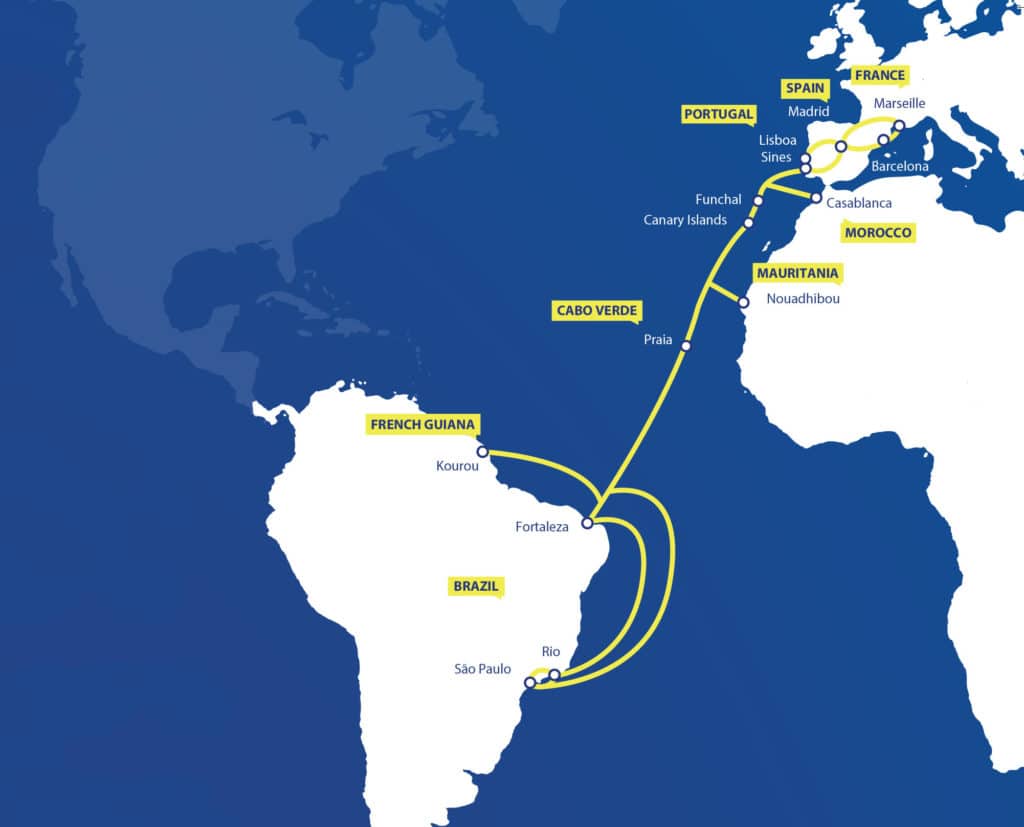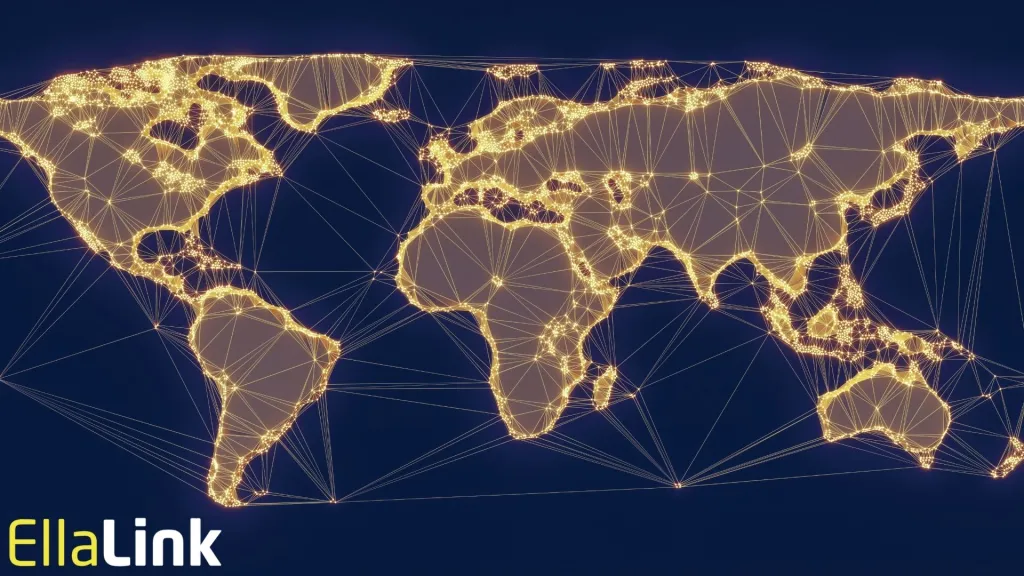Sines: the new gateway from Latin America to Europe
The Peninsula is becoming an alternative interconnection between Europe and other continents. As a result, the new gateway is gaining weight, and Sines is the key pieces.
The Iberian Peninsula is the gateway to Europe, where connections to the Americas, Africa, the Middle East and even Asia converge, taking advantage of the Mediterranean Sea. It is a strategic geographical position unique in the world.
Today, as at the time of the discoveries 500 years ago, the Peninsula once again occupies a central position in the world. For centuries, Portugal and Spain were the gateway to Europe by sea and were commercial hubs for raw materials and quality products worldwide.
At the start of the 21st century, the Peninsula occupies a strategic position by maintaining that centrality, but this time through the interconnection points of undersea cables from four continents that allow access to the Internet without faults.
The connection by submarine cable between Sines and Lisbon was the missing link to pave the way for the acceleration of connectivity by submarine cable between Sines and Europe. The EllaLink submarine cable directly connecting Fortaleza and Sines, halves the latency between the two continents. It has gone from over 100 milliseconds for traditional routes to around 50 milliseconds, as Theresa Bobis, regional director of DE-CIX, the largest neutral interconnection ecosystem, data centres and data distribution, recalled recently.
The importance of latency
Latency is the time it takes for a message to get from point A to point B. All digital applications are latency sensitive and dependent on latency to function properly. Digitalisation is part of our daily life, both in the personal and professional dimensions, in areas as diverse as distance learning, e-health and even in moments of fun through online gaming or streaming music, movies or series. In more critical applications, a few milliseconds can make the difference between winning an online championship or losing in the stock market due to delays in the propagation of the buy or sell order.
65 milliseconds is a latency that allows a good quality experience over distances of 5,500 kilometres or between Sines in Portugal and Fortaleza in Brazil.
All future investments in performance, security, and quality of consumer experience will depend on latency.
Relationship between Portugal and Madrid
Lisbon is directly connected to the largest neutral interconnection ecosystem in Southern Europe, Madrid, Barcelona, and Marseille and Frankfurt in the centre of Europe.
All the indications are that intercontinental networks will increasingly opt for the Iberian Peninsula rather than locations further north to reach European networks and international content providers.
DE-CIX and EllaLink are partnering to build a robust new intercontinental ecosystem linking Europe, Africa and South America. DE-CIX has data centres in Lisbon, Madrid, Barcelona and Marseille, and EllaLink is committed to developing a new gateway to Europe with a connect.
Madrid has everything needed for interconnectivity
Besides its privileged geographical position, at the centre of a 5,500-kilometre radius perimeter covering several continents, four assets make the Peninsula an international digital hub:
- Interconnectivity: The digital interconnection of the Iberian Peninsula through landing stations is under development; Data flow has grown by more than 140% per year since the 2020/2021 pandemic. In Madrid, in the data-neutral interconnection ecosystem (DE-CIX, a strategic partner of EllaLink), more than a terabit of traffic passes.
- Cables and connectivity: Intercontinental connectivity has been increasing with the completion of three new submarine cable networks connecting the Peninsula and America (Grace Hooper and EllaLink) and the African continent (2Africa), and more will come in the next six to nine months.
- Digital industry: Huge cloud infrastructures have chosen the Peninsula to establish themselves - some in Sines and Lisbon - promoted by companies such as Google, Oracle, IBM, Microsoft, to Amazon.
- Data centres: Within three years, in 2026, Madrid will reach a capacity of 621 mW, multiplying computing power by more than five in five years.
Portugal has added motives
But there is much more. The list of reasons why Iberia is being looked at closely by the different players in the interconnection ecosystem is vast:
- The Iberian Peninsula, in general, Portugal and Sines are still central in terms of time zone. Portugal shares the time zone with the United Kingdom (one of Europe's main business centres); the time difference concerning other countries in Europe or Africa is residual. The difference with the Americas is reasonable, which allows working with these regions without major disturbances. To give just one example, the New York Stock Exchange opens at 2.30 pm in Portugal.
- The Peninsula also has cultural proximity, both with Latin America and Europe, excellent digital infrastructure and increased investment in data centres.
- The Atlantic western front seems designed to position submarine cable connections and install data centres.
Sines: the best of several worlds
The port of Sines is unrecognisable. The Sines Industrial and logistics zone (ZILS) includes mooring for submarine cables, data centres, and energy production. Moreover, it is close to the sea and water needed for cooling technological infrastructures with reduced environmental impact.
The development of the industrial zone also benefits from the involvement of the municipality and other organisations, such as SinesTech.
A technology company that sets up in Sines will be able to optimise costs, improve efficiency and, naturally, increase the quality of service. Compared to other regions of the globe, Portugal, and Sines in particular, has advantages almost unattainable by others.
Portugal, Lisbon and Sines, in particular, are increasingly obvious choices for hyperscale data centres.
Stable electricity grid, renewable energy and accessible water
The power supply is crucial for operating undersea cables and data centres. A few minutes of failure can cause huge losses. ZILS has a power grid infrastructure that ensures an abundant and redundant power supply.
In the vicinity of ZILS is a vast renewable energy production that includes wind and photovoltaic farms. For this year, it is also planned the completion and connection to the grid of a new solar plant in Morgavel, Sines that will have the capacity to produce 49 mW of energy.
In Sines, there are large reserves of water for industrial use and seawater. This water is essential to keep the data centres at the ideal temperature.
All this explains why the Peninsula, Madrid, Lisbon and Sines are key elements for Southern Europe to be recognised as the new gateway for data in the Old Continent.
Let's keep this conversation going and set up a follow up call.
You May Also Like
Fibre-optic cables: the present and future of digital technology
Fibre-optic cables are responsible for 99% of the data and voice traffic that flows across the inter
LATAM X Europe low latency games is now possible thanks to EllaLinks
Approximately 85 million Brazilian online gamers are rejoicing with the opening of a high-speed comm
What are submarine cable?
Oceanic data transmission is made possible through submarine cables, which link continents and are e


